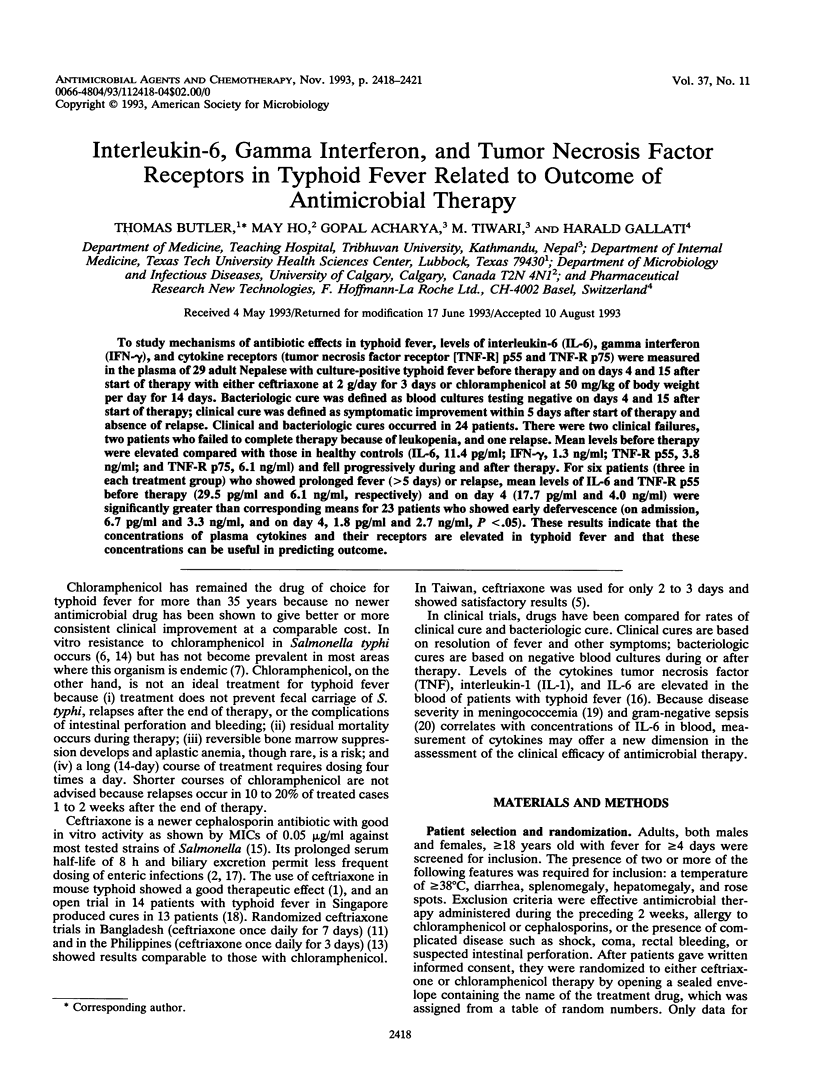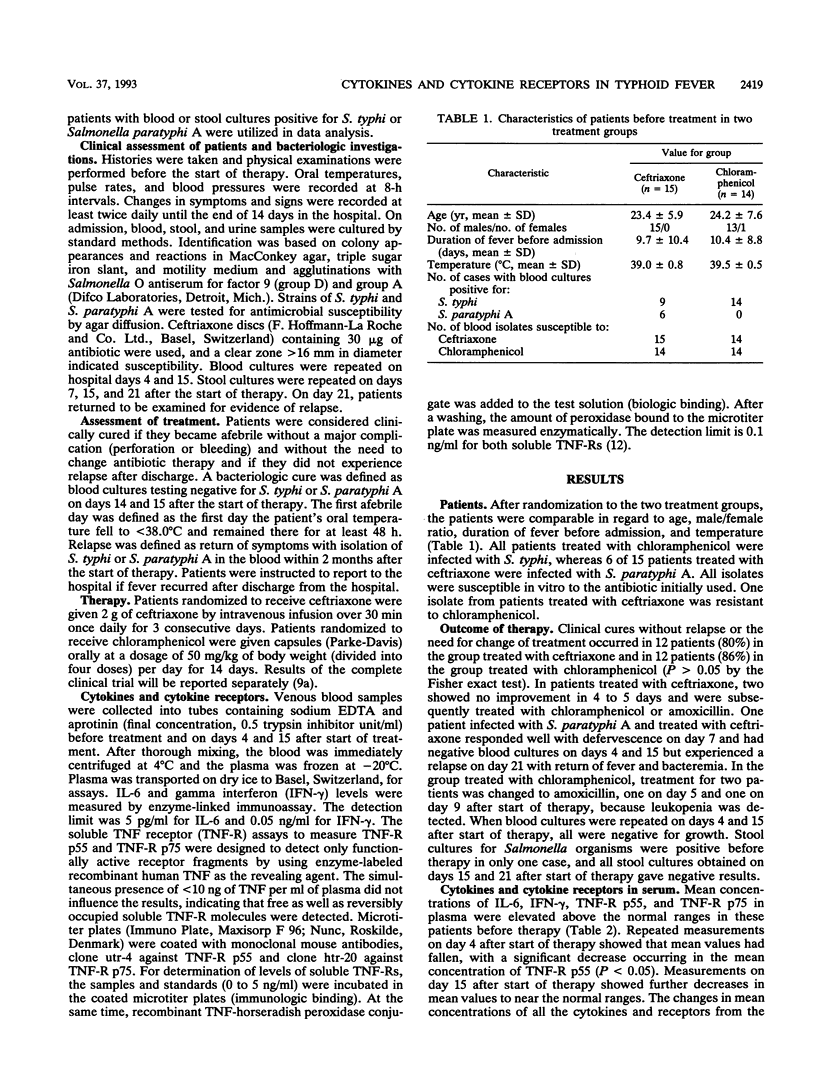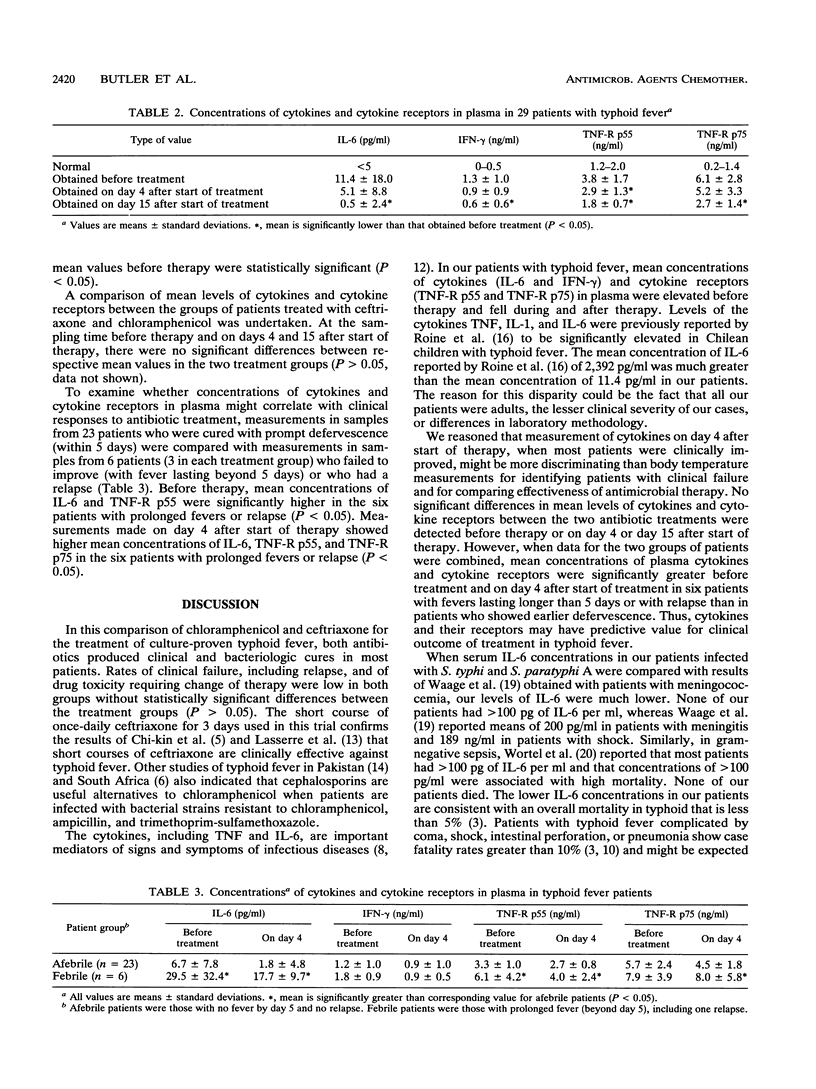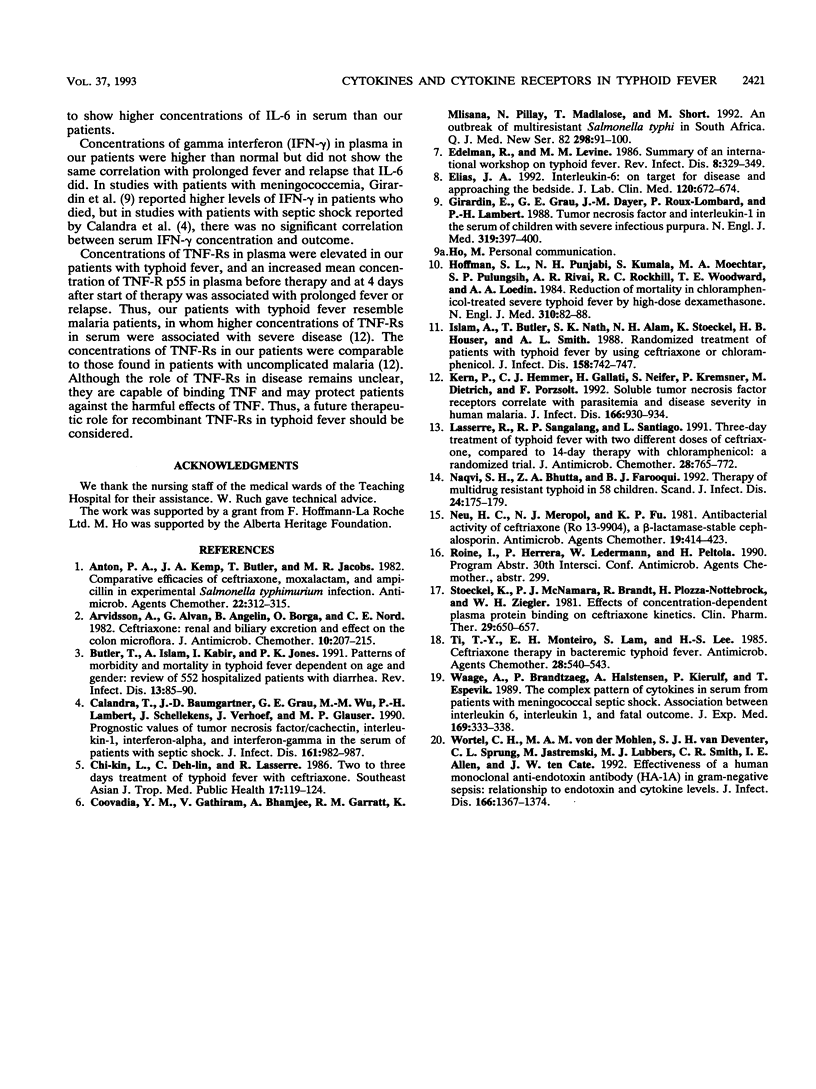Abstract
To study mechanisms of antibiotic effects in typhoid fever, levels of interleukin-6 (IL-6), gamma interferon (IFN-gamma), and cytokine receptors (tumor necrosis factor receptor [TNF-R] p55 and TNF-R p75) were measured in the plasma of 29 adult Nepalese with culture-positive typhoid fever before therapy and on days 4 and 15 after start of therapy with either ceftriaxone at 2 g/day for 3 days or chloramphenicol at 50 mg/kg of body weight per day for 14 days. Bacteriologic cure was defined as blood cultures testing negative on days 4 and 15 after start of therapy; clinical cure was defined as symptomatic improvement within 5 days after start of therapy and absence of relapse. Clinical and bacteriologic cures occurred in 24 patients. There were two clinical failures, two patients who failed to complete therapy because of leukopenia, and one relapse. Mean levels before therapy were elevated compared with those in healthy controls (IL-6, 11.4 pg/ml; IFN-gamma, 1.3 ng/ml; TNF-R p55, 3.8 ng/ml; and TNF-R p75, 6.1 ng/ml) and fell progressively during and after therapy. For six patients (three in each treatment group) who showed prolonged fever (> 5 days) or relapse, mean levels of IL-6 and TNF-R p55 before therapy (29.5 pg/ml and 6.1 ng/ml, respectively) and on day 4 (17.7 pg/ml and 4.0 ng/ml) were significantly greater than corresponding means for 23 patients who showed early defervescence (on admission, 6.7 pg/ml and 3.3 ng/ml, and on day 4, 1.8 pg/ml and 2.7 ng/ml, P < .05). These results indicate that the concentrations of plasma cytokines and their receptors are elevated in typhoid fever and that these concentrations can be useful in predicting outcome.
Full text
PDF



Selected References
These references are in PubMed. This may not be the complete list of references from this article.
- Anton P. A., Kemp J. A., Butler T., Jacobs M. R. Comparative efficacies of ceftriaxone, moxalactam, and ampicillin in experimental Salmonella typhimurium infection. Antimicrob Agents Chemother. 1982 Aug;22(2):312–315. doi: 10.1128/aac.22.2.312. [DOI] [PMC free article] [PubMed] [Google Scholar]
- Arvidsson A., Alván G., Angelin B., Borgå O., Nord C. E. Ceftriaxone: renal and biliary excretion and effect on the colon microflora. J Antimicrob Chemother. 1982 Sep;10(3):207–215. doi: 10.1093/jac/10.3.207. [DOI] [PubMed] [Google Scholar]
- Butler T., Islam A., Kabir I., Jones P. K. Patterns of morbidity and mortality in typhoid fever dependent on age and gender: review of 552 hospitalized patients with diarrhea. Rev Infect Dis. 1991 Jan-Feb;13(1):85–90. doi: 10.1093/clinids/13.1.85. [DOI] [PubMed] [Google Scholar]
- Calandra T., Baumgartner J. D., Grau G. E., Wu M. M., Lambert P. H., Schellekens J., Verhoef J., Glauser M. P. Prognostic values of tumor necrosis factor/cachectin, interleukin-1, interferon-alpha, and interferon-gamma in the serum of patients with septic shock. Swiss-Dutch J5 Immunoglobulin Study Group. J Infect Dis. 1990 May;161(5):982–987. doi: 10.1093/infdis/161.5.982. [DOI] [PubMed] [Google Scholar]
- Coovadia Y. M., Gathiram V., Bhamjee A., Garratt R. M., Mlisana K., Pillay N., Madlalose T., Short M. An outbreak of multiresistant Salmonella typhi in South Africa. Q J Med. 1992 Feb;82(298):91–100. [PubMed] [Google Scholar]
- Edelman R., Levine M. M. Summary of an international workshop on typhoid fever. Rev Infect Dis. 1986 May-Jun;8(3):329–349. doi: 10.1093/clinids/8.3.329. [DOI] [PubMed] [Google Scholar]
- Elias J. A. Interleukin-6: on target for disease and approaching the bedside. J Lab Clin Med. 1992 Nov;120(5):672–674. [PubMed] [Google Scholar]
- Girardin E., Grau G. E., Dayer J. M., Roux-Lombard P., Lambert P. H. Tumor necrosis factor and interleukin-1 in the serum of children with severe infectious purpura. N Engl J Med. 1988 Aug 18;319(7):397–400. doi: 10.1056/NEJM198808183190703. [DOI] [PubMed] [Google Scholar]
- Hoffman S. L., Punjabi N. H., Kumala S., Moechtar M. A., Pulungsih S. P., Rivai A. R., Rockhill R. C., Woodward T. E., Loedin A. A. Reduction of mortality in chloramphenicol-treated severe typhoid fever by high-dose dexamethasone. N Engl J Med. 1984 Jan 12;310(2):82–88. doi: 10.1056/NEJM198401123100203. [DOI] [PubMed] [Google Scholar]
- Islam A., Butler T., Nath S. K., Alam N. H., Stoeckel K., Houser H. B., Smith A. L. Randomized treatment of patients with typhoid fever by using ceftriaxone or chloramphenicol. J Infect Dis. 1988 Oct;158(4):742–747. doi: 10.1093/infdis/158.4.742. [DOI] [PubMed] [Google Scholar]
- Kern P., Hemmer C. J., Gallati H., Neifer S., Kremsner P., Dietrich M., Porzsolt F. Soluble tumor necrosis factor receptors correlate with parasitemia and disease severity in human malaria. J Infect Dis. 1992 Oct;166(4):930–934. doi: 10.1093/infdis/166.4.930. [DOI] [PubMed] [Google Scholar]
- Lan C. K., Cheng D. L., Lasserre R. Two to three days treatment of typhoid fever with ceftriaxone. Southeast Asian J Trop Med Public Health. 1986 Mar;17(1):119–124. [PubMed] [Google Scholar]
- Lasserre R., Sangalang R. P., Santiago L. Three-day treatment of typhoid fever with two different doses of ceftriaxone, compared to 14-day therapy with chloramphenicol: a randomized trial. J Antimicrob Chemother. 1991 Nov;28(5):765–772. doi: 10.1093/jac/28.5.765. [DOI] [PubMed] [Google Scholar]
- Naqvi S. H., Bhutta Z. A., Farooqui B. J. Therapy of multidrug resistant typhoid in 58 children. Scand J Infect Dis. 1992;24(2):175–179. doi: 10.3109/00365549209052609. [DOI] [PubMed] [Google Scholar]
- Neu H. C., Meropol N. J., Fu K. P. Antibacterial activity of ceftriaxone (Ro 13-9904), a beta-lactamase-stable cephalosporin. Antimicrob Agents Chemother. 1981 Mar;19(3):414–423. doi: 10.1128/aac.19.3.414. [DOI] [PMC free article] [PubMed] [Google Scholar]
- Stoeckel K., McNamara P. J., Brandt R., Plozza-Nottebrock H., Ziegler W. H. Effects of concentration-dependent plasma protein binding on ceftriaxone kinetics. Clin Pharmacol Ther. 1981 May;29(5):650–657. doi: 10.1038/clpt.1981.90. [DOI] [PubMed] [Google Scholar]
- Ti T. Y., Monteiro E. H., Lam S., Lee H. S. Ceftriaxone therapy in bacteremic typhoid fever. Antimicrob Agents Chemother. 1985 Oct;28(4):540–543. doi: 10.1128/aac.28.4.540. [DOI] [PMC free article] [PubMed] [Google Scholar]
- Waage A., Brandtzaeg P., Halstensen A., Kierulf P., Espevik T. The complex pattern of cytokines in serum from patients with meningococcal septic shock. Association between interleukin 6, interleukin 1, and fatal outcome. J Exp Med. 1989 Jan 1;169(1):333–338. doi: 10.1084/jem.169.1.333. [DOI] [PMC free article] [PubMed] [Google Scholar]
- Wortel C. H., von der Möhlen M. A., van Deventer S. J., Sprung C. L., Jastremski M., Lubbers M. J., Smith C. R., Allen I. E., ten Cate J. W. Effectiveness of a human monoclonal anti-endotoxin antibody (HA-1A) in gram-negative sepsis: relationship to endotoxin and cytokine levels. J Infect Dis. 1992 Dec;166(6):1367–1374. doi: 10.1093/infdis/166.6.1367. [DOI] [PubMed] [Google Scholar]


